








| Previous | Back to index | Next |
A lone cell has no neighbours and dies off in the next generation.
Any pattern of only two cells will die in the next generation since each cell has only one neighbour.
Three distinct patterns of three cells are possible:
 |
 |
 |
 |
 |
 |
 |
 |
 |
The first of these patterns is commonly produced during the evolution of other patterns, and is called a blinker. The end cells die in the next generation, having only one neighbour each, but the cells on either side have three neighbours and thus are born into the next generation. It repeats this every two generations; for this reason this type of pattern is called an oscillator of period 2.
The second pattern survives into the second generation, but since the second-generation pattern consists of only two cells, it dies out in the third generation.
All of the live cells in the third pattern have two neighbours and thus survive into generation 1 (the first generation is called generation 0). In addition, one dead cell has three neighbours and is born into generation 1. All of the live cells in generation 1 have three neighbours, and none of the surrounding dead cells have three neighbours, so it remains the same in the next generation. This type of pattern is called a still life, and this particular still life is called a block.
Here are some patterns starting with 5 cells:
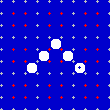 |
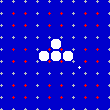 |
The A-shape turns into the T-shape and continues as for the T (see below). |
 |
 |
 |
 |
The C-shape turns into another C-shape and dies out in generation 3.
 |
 |
 |
 |
The h-shape turns into the r-shape and grows erratically, eventually stabilising into six gliders, four blinkers and a number of still lives. (These terms will be explained later.)
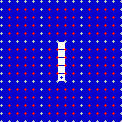 |
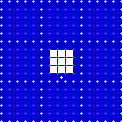 |
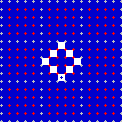 |
 |
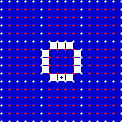 |
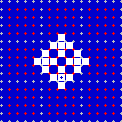 |
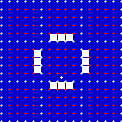 |
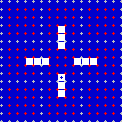 |
The straight line (I-shape) becomes four blinkers.
Interestingly, the patterns consisting solely of an unbroken row of cells evolve into very different lifeforms:
... and so on, with no apparent pattern. (See the next section for explanations of terms such as 'beehive'.)
An oscillator is a pattern which repeats itself over a (finite) number of generations. We have already met one of these, the three-celled blinker. There are many other oscillators of many periods – in fact, it is conjectured that there are oscillators of all periods. It is perhaps worth noting that still lives are in fact oscillators of period 1.
Here are some named oscillators:
 |
 |
 |
 |
 |
Above: the barber's pole, clock, toad, phoenix and traffic lights. The first can be extended arbitrarily far in either direction; the fourth dies out, but is reborn in the next generation; the last is just a set of four blinkers, but is common enough to warrant a name. Beehives also frequently occur in this configuration.
A number of patterns repeat themselves like oscillators, but translated a few cells in one direction. Such patterns are called spaceships.
By far the most common spaceship is the glider:
 |
 |
 |
 |
 |
This spaceship moves diagonally at speed c/4. c is the 'speed of light', which is one cell per generation in any direction. c/4 is the maximum speed of any diagonal spaceship.
Somewhat less common are the standard spaceships: lightweight, middleweight and heavyweight, which follow much the same pattern:
 |
 |
 |
 |
 |

| 
|
These ships travel orthogonally at c/2, which is the maximum speed for orthogonal spaceships. The MWSS and HWSS (as they are abbreviated) are one and two cells longer, respectively, than the LWSS. An important aspect of these patterns is the 'sparks' they leave behind – the LWSS leaves one spark of only one cell; the MWSS leaves behind two of one cell, and the HWSS leaves one of 2 cells and one of 1 cell.
There are other kinds of spaceship, but these are by far the most common.
Of special note is the fishhook. Its interest lies in the fact that it can destroy (or 'eat', hence its other name) other patterns, especially gliders:
 |
 |
 |
 |
| Previous | Back to index | Next |